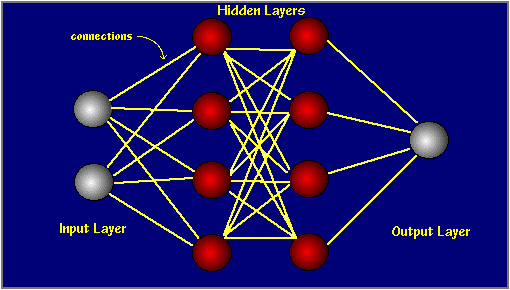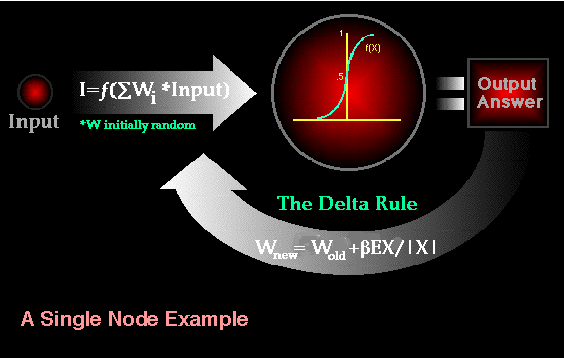How to Make a Node Read Backwards



A Bones Introduction To Neural Networks

What Is A Neural Network?
The simplest definition of a neural network, more properly referred to as an 'bogus' neural network (ANN), is provided by the inventor of one of the first neurocomputers, Dr. Robert Hecht-Nielsen. He defines a neural network as:"...a computing system fabricated up of a number of simple, highly interconnected processing elements, which process data past their dynamic state response to external inputs.ANNs are processing devices (algorithms or actual hardware) that are loosely modeled afterwards the neuronal structure of the mamalian cerebral cortex only on much smaller scales. A big ANN might have hundreds or thousands of processor units, whereas a mamalian brain has billions of neurons with a respective increase in magnitude of their overall interaction and emergent behavior. Although ANN researchers are generally not concerned with whether their networks accurately resemble biological systems, some have. For example, researchers have accurately faux the function of the retina and modeled the heart rather well.In "Neural Network Primer: Office I" by Maureen Caudill, AI Skilful, Feb. 1989
Although the mathematics involved with neural networking is non a little matter, a user can rather easily gain at to the lowest degree an operational understanding of their structure and function.
The Basics of Neural Networks
Neural neworks are typically organized in layers. Layers are made up of a number of interconnected 'nodes' which contain an 'activation function'. Patterns are presented to the network via the 'input layer', which communicates to one or more 'hidden layers' where the actual processing is done via a system of weighted 'connections'. The hidden layers then link to an 'output layer' where the respond is output as shown in the graphic below.
Near ANNs contain some grade of 'learning rule' which modifies the weights of the connections according to the input patterns that it is presented with. In a sense, ANNs larn by example every bit practice their biological counterparts; a child learns to recognize dogs from examples of dogs.
Although there are many dissimilar kinds of learning rules used by neural networks, this demonstration is concerned merely with 1; the delta rule. The delta rule is oft utilized by the about common form of ANNs chosen 'backpropagational neural networks' (BPNNs). Backpropagation is an abridgement for the backwards propagation of fault.
With the delta dominion, as with other types of backpropagation, 'learning' is a supervised process that occurs with each cycle or 'epoch' (i.e. each time the network is presented with a new input pattern) through a forward activation flow of outputs, and the backwards fault propagation of weight adjustments. More just, when a neural network is initially presented with a pattern information technology makes a random 'guess' equally to what information technology might exist. It then sees how far its answer was from the bodily 1 and makes an appropriate aligning to its connectedness weights. More graphically, the process looks something like this:

Note besides, that within each hidden layer node is a sigmoidal activation office which polarizes network activity and helps it to stablize.
Backpropagation performs a gradient descent within the solution's vector infinite towards a 'global minimum' along the steepest vector of the fault surface. The global minimum is that theoretical solution with the lowest possible error. The fault surface itself is a hyperparaboloid but is seldom 'smooth' as is depicted in the graphic below. Indeed, in well-nigh problems, the solution space is quite irregular with numerous 'pits' and 'hills' which may cause the network to settle down in a 'local minum' which is non the best overall solution. 
Since the nature of the error space tin not exist known a prioi, neural network analysis often requires a large number of individual runs to make up one's mind the best solution. Most learning rules take congenital-in mathematical terms to assist in this procedure which command the 'speed' (Beta-coefficient) and the 'momentum' of the learning. The speed of learning is actually the rate of convergence betwixt the current solution and the global minimum. Momentum helps the network to overcome obstacles (local minima) in the error surface and settle down at or nearly the global miniumum.
Once a neural network is 'trained' to a satisfactory level information technology may be used as an analytical tool on other information. To exercise this, the user no longer specifies whatever preparation runs and instead allows the network to work in forwards propagation manner only. New inputs are presented to the input pattern where they filter into and are processed by the middle layers equally though grooming were taking place, however, at this point the output is retained and no backpropagation occurs. The output of a forwards propagation run is the predicted model for the information which can and then be used for further analysis and estimation.
It is also possible to over-train a neural network, which means that the network has been trained exactly to answer to but one type of input; which is much like rote memorization. If this should happen then learning can no longer occur and the network is refered to as having been "grandmothered" in neural network jargon. In existent-world applications this situation is not very useful since one would demand a split up grandmothered network for each new kind of input.
How Practise Neural Networks Differ From Conventional Computing?
To better understand bogus neural computing it is of import to know start how a conventional 'serial' computer and it's software procedure data. A serial computer has a central processor that can address an array of memory locations where data and instructions are stored. Computations are made by the processor reading an didactics as well as any data the education requires from retentiveness addresses, the education is and so executed and the results are saved in a specified memory location as required. In a serial system (and a standard parallel one every bit well) the computational steps are deterministic, sequential and logical, and the state of a given variable tin can exist tracked from one operation to some other.In comparing, ANNs are not sequential or necessarily deterministic. In that location are no circuitous primal processors, rather in that location are many unproblematic ones which generally do nothing more than take the weighted sum of their inputs from other processors. ANNs do not execute programed instructions; they reply in parallel (either simulated or actual) to the blueprint of inputs presented to it. There are also no carve up memory addresses for storing data. Instead, information is contained in the overall activation 'land' of the network. 'Knowledge' is thus represented by the network itself, which is quite literally more the sum of its individual components.
What Applications Should Neural Networks Be Used For?
Neural networks are universal approximators, and they work all-time if the organisation y'all are using them to model has a high tolerance to error. One would therefore non be advised to use a neural network to rest one's cheque book! However they work very well for:- capturing associations or discovering regularities within a set of patterns;
- where the volume, number of variables or diversity of the information is very great;
- the relationships betwixt variables are vaguely understood; or,
- the relationships are difficult to draw adequately with conventional approaches.
What Are Their Limitations?
There are many advantages and limitations to neural network analysis and to discuss this subject area properly we would have to await at each individual type of network, which isn't necessary for this general discussion. In reference to backpropagational networks however, there are some specific bug potential users should be aware of.- Backpropagational neural networks (and many other types of networks) are in a sense the ultimate 'black boxes'. Apart from defining the general archetecture of a network and perhaps initially seeding it with a random numbers, the user has no other office than to feed it input and scout it train and look the output. In fact, it has been said that with backpropagation, "y'all almost don't know what you're doing". Some software freely available software packages (NevProp, bp, Mactivation) do allow the user to sample the networks 'progress' at regular time intervals, but the learning itself progresses on its own. The final product of this activity is a trained network that provides no equations or coefficients defining a human relationship (as in regression) across it's own internal mathematics. The network 'IS' the final equation of the relationship.
- Backpropagational networks too tend to be slower to train than other types of networks and sometimes require thousands of epochs. If run on a truly parallel computer system this issue is not really a trouble, but if the BPNN is being simulated on a standard serial car (i.east. a single SPARC, Mac or PC) grooming can take some time. This is because the machines CPU must compute the function of each node and connection separately, which tin be problematic in very large networks with a large corporeality of information. Notwithstanding, the speed of about current machines is such that this is typically not much of an effect.
What Are Their Advantages Over Conventional Techniques?
Depending on the nature of the application and the forcefulness of the internal data patterns you tin by and large expect a network to train quite well. This applies to problems where the relationships may exist quite dynamic or not-linear. ANNs provide an analytical culling to conventional techniques which are often limited past strict assumptions of normality, linearity, variable independence etc. Because an ANN can capture many kinds of relationships information technology allows the user to quickly and relatively easily model phenomena which otherwise may have been very difficult or imposible to explain otherwise. For further information on neural networks on the WWW.
For further information on neural networks on the WWW. 
 Back To Main Page
Back To Main Page
 Run into an example of a neural network.
Run into an example of a neural network.
How to Make a Node Read Backwards
Source: https://pages.cs.wisc.edu/~bolo/shipyard/neural/local.html